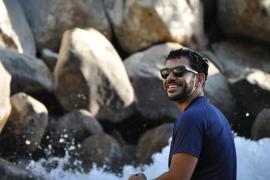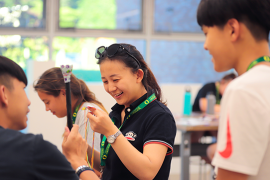Hi everyone,
Summer 2021 — just like that, it’s nearly over! For some of you, camp may already be finished and for others, you’re just wrapping things up now. But either way, congratulations. This was quite a year and you’ve made it through.
Amid programming, staffing, health forms, COVID-19 protocols, and all those little fires you put out every day, it’s possible that you didn’t have a ton of time to dedicate to continuous quality improvement and collecting data. But I want to show you that no matter what data you have, you can use it to make impactful changes at camp.
Hold up . . . rewind . . . Yes, that’s right, you heard me. I said data. For those of you who have flashing warning alarms going off in your mind, I want to put a stop to that right now.
Data is not scary. It’s not difficult. It’s not confusing. It’s actually informative, important, and essential for continuous quality improvement. Let me break it down for you . . .
Data and Continuous Quality Improvement
Just as a reminder:
- Data is information that you collect in the form of numbers (quantitative data) or words (qualitative data)
- Continuous quality improvement (CQI) is the complete process of identifying, describing, and analyzing strengths and problems and then testing, implementing, learning from, and revising solutions.[i]
Simply put, continuous quality improvement is the process of collecting data, using it to improve, and completing these steps again.
CQI and associated data collection can be planned in advance (e.g., using the Prepare-Assess-Plan-Improve cycle that we’re using with the Camp Program Quality Initiative), or it can be done by focusing on data you already have, thinking about what it means, and making improvements based on the data. This latter approach is what we’re talking about in today’s blog.
CQI with the Data You Already Have
No matter what type of data you have, it can be used to make impactful changes to your program. Take what information you have, thoughtfully review it, make note of any trends you’re seeing, openly and honestly speak with other trusted staff about why the trends are occurring, and brainstorm potential improvements.
Check out the table below for some examples.
Information |
What It Might Show |
Potential Improvement |
|
Camper demographics (e.g., home location, age) |
|
|
|
Satisfaction surveys (e.g., activity reviews) |
|
|
|
End of summer feedback forms (e.g., staff reviews of their experience) |
|
|
An Example from Tim Hortons Foundation Camps
The above are hypothetical examples of CQI, but real camp directors are engaging in this type of cycle already. Here, I present an example from Katie Wheatley, Executive Youth Development Officer at Tim Hortons Foundation Camps. I spoke to Katie about using data to inform program improvement. She shared about their pivot to virtual camp during the summer of 2020 and a mini cycle of CQI. Katie already had information about youth participation that sparked a question and a potential area of improvement, and her and her team decided to collect additional camper input via social media to understand what improvement would be best for the campers.
Katie: Last summer we were trying to leverage social media and we started doing little fun polls with our youth on Instagram so we could get quicker, more casual responses and feedback from our campers. We found that approach to be a bit of a silver lining because we don’t want to wait for the next formal focus group or formal survey. Plus, this way we were able to make some changes a lot faster than we had been able to in the past.
For example, with our virtual programs we were tracking the times that we were offering different types of programs, the age of kids that were showing up, and where they were located. Typically, we have kids come to our 7 different program sites from all over the United States and Canada and with the different time zones for virtual program offerings, it got operationally challenging! Our goal was to try and get as many kids to different program offerings as possible to create more community, and so they would be more engaged and really wanting to come back and come to next week’s program.
Initially we realized that with some of the times we were offering programs, we weren’t capturing the age groups that we wanted to capture. In particular, our older youth weren’t showing up to programming, so we asked them on Instagram, “what time would work better for you?” And we actually ended up offering program for them at 10pm Eastern time because they were like, “that’s the only time I’m done work, I’m not interrupted by my siblings, and I have access to the computer.”
That was a really great opportunity to do a mini improvement cycle. We had some information already, reached out to get more information, thought about what it meant and how we could address the issue to make positive changes for our youth.
To read more from Katie about Tim Hortons Foundation Camps and their work, read her four part blog series “Helping Kids Change Their Stories: A Taste of Camp Measurement North of the Border” here, here, here, and here.
CQI doesn’t have to be complicated. Now that it’s the end of summer, think about what information you have on hand from this year’s camp season and consider different ways to use that information to improve. You can make changes to policies, programming, staff training, camper recruitment, the website, the camp store, lunch offerings . . . the list goes on!
[i] National Child Welfare Resource Center for Organizational Improvement and Casey Family Programs. (2005). Using continuous quality improvement to improve child welfare practice. http://muskie.usm.maine.edu/helpkids/rcpdfs/CQIFramework.pdf
Katie Wheatley, Executive Youth Development Office with Tim Hortons Foundation Camps, specializes in data-driven curriculum design for youth who thrive in alternative learning environments. With a background in special education, Katie combines her passion for education and experience in camping to lead the innovation, measurement and development of Tim Hortons Foundation Camps programs in Canada and the US. For more information about Tim Hortons Foundation Camps, please visit timhortons.com/foundation.
Victoria Povilaitis, American Camp Association: Victoria recently completed her PhD at the University of Utah and now works at ACA as a Research Associate. She is a long-time summer camp program director and staffing director. Through her academic work she aims to bridge research and practice and hopes to develop tools and strategies that camp professionals can use when working with campers and staff to facilitate positive experiences for everyone who engages with camp.
Thanks to our research partner, Redwoods.
Additional thanks goes to our research supporter, Chaco.


